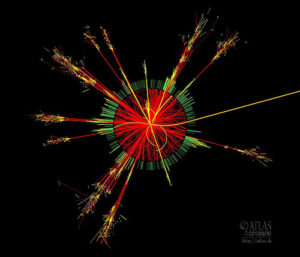Is momentum conserved in an elastic collision? Certainly yes, the momentum which is the strength of the force and energy that drives the object will be conserved.
Momentum will enhance the mass of an object to move further in motion when the velocity changes. Momentum is the quantity responsible for the object under motion, even the velocity changes.
Generally, momentum is the product of velocity and mass when an object goes into motion. All of this is conserved in an elastic collision only because the mass will not change or by any other means.
In elastic collision, the bodies under collision will have their own kinetic energy and momentum. So when they collide with each other, the momentum will be exchanged and also the kinetic energy.
In this way, when we deep look at objects or bodies under constant motion, when they collide with each other, they will definitely exchange the energies and momentum, so there is conservation happening at the collision before and after.
When we usually talk about the momentum, we generally talk about the strength of the force that is acting upon the object that is under motion.

Why is momentum conserved in an elastic collision?
The one main reason as to is momentum conserved in an elastic collision is that there is basically no loss of anything before and after the collision. Hence it is proven that the elastic collision is one of the proofs that kinetic energy can be conserved at any cost.
Let us take an example and understand this better. There are two sets of ball displaced from a rigid surface and is allowed to swing to and forth. So when the balls of both sides swing together in and out without leaving the constant motion, then it is said to be elastic.
When one ball of one set and the other of the second set swing in opposite directions from their equilibrium positions, respectively, then the kinetic energy is not said to be conserved, and then it becomes an inelastic collision.
In this way, we can make out that the kinetic energy of any system before and after any motion should be conserved only then it is said to be elastic motion. In linear motion, the momentum is conserved until the motion is straight for a long time.
Also, elastic collision will consider only the linear momentum into account and will also act accordingly. In an inelastic collision, the colliding bodies stick to one another and will result in no conservation of momentum in the whole process.
When is momentum conserved in an elastic collision?
Basically, for momentum to be conserved in an isolated system, there must be zero external force acting on that particular system taken into consideration. So there is a loss of momentum and kinetic energy per se.
For a motion to happen, there are several factors that aid in its further movement. One such is the momentum along with the friction and so many. Here all these factors make an impact on the momentum also.
When there is continuous friction, the momentum will definitely be affected by it. So when the path of the motion is rough, the friction will be more, and when the path is smooth, the friction will be smooth and also die out soon.
When these factors like friction and external force affect the momentum, then there will be a change in the momentum of the system. So when the kinetic energy of the colliding bodies are the same before and after the collision, then the momentum of the system is said to be conserved.
Momentum is said to have both magnitude and direction for a body that is under constant motion. Now we need to know how linear momentum is conserved in a system and how it is not.
When a ball is allowed to fall to the ground, it is because of the presence of gravity. So there is no momentum conserved. Because it falls to the ground and comes to contact with the floor so once again, momentum is not conserved o after the rebound, there is a possibility of momentum conservation.

Is momentum conserved in a superelastic collision?
Yes, the momentum can be conserved on a superelastic collision. For example, there is a collision, and the potential energy will be indeed converted as kinetic energy, so the kinetic energy will be greater after the collision.
In this process of conversion of potential energy to kinetic energy, there will be a conservation of momentum in it. The momentum will be conserved in all types of elastic collision, whether it is super elastic, perfect collision, or partial collision.
We know that super collision means the kinetic energy will be greater after the collision process. Why does this happen? During a collision of two bodies in an isolated system, there will be an increase in kinetic energy by the conservation of it.
During a particle collision, if it is considered to be a super elastic collision, the potential energy will instantly to kinetic energy. When the particles are rest, they will have potential energy, and when they are put in motion in order to collide, they will have kinetic energy.
So by this way, the kinetic energy will be more after the collision in a super elastic collision. When considering this, we also must know that momentum is simply the amount of force to be applied in order to move the particle in motion when velocity changes.
So momentum will remain the same and is conserved irrespective of the types of elastic collisions considered.
Is momentum conserved in a perfectly elastic collision?
The perfectly elastic collision is the collision in which the body in motion loses neither energy nor momentum in that particular given collision process. When two bodies collide with each other, there is no loss of momentum or energy. This is regarded to be the perfect elastic collision.
Momentum is not lost in this process because the kinetic energy created by the particle in the process remains the same and is not lost. Momentum is the quantity of the force that will have to be applied by the body when the speed is changed.
For example, we consider two particles to collide with each other they are said to have kinetic energy that never will change and will be conserved at the end of the process. Momentum will be conserved because there will be no external force acting on the two bodies that are colliding.
Few instances where we see that in an elastic collision, there will be a conservation of momentum and energy. In billiards, when a ball hits another ball, there is an elastic collision occurring.
It is seen that the kinetic energy and the momentum are transferred to another ball but are not lost. Similarly, when a ball is thrown to the ground and bounces back, there is a net force that is there. So the energy and momentum are instantly conserved.

Is momentum conserved in partially elastic collisions?
The momentum meaning the strength of force is not really been conserved in this type of collision. These are the real-time collisions in the world. The colliding bodies rarely stick to each other, and the kinetic energy has been lost.
The partial elastic collision is also regarded as the inelastic collision but with very few deviations. When a ball loses its velocity after the motion comes to rest, there is no energy conserved, and in turn, momentum is also not conserved.
Partially elastic collisions are the most common collision found in the real world. There is a loss of kinetic energy which has been converted from the potential energy will be lost in the form of friction. Also, heat and sound are also lost in the form of energy. So there is no chance for the momentum to be lost.
For example, we consider a bullet fired from the gun. The velocity of the bullet is lost once it hits the target. Since the velocity of the target is not as same as the velocity of the bullet, the process is considered to be the inelastic collision, and the momentum is certainly not conserved.
Similarly, with bow and arrow, the velocity of the arrow does not remain the same after releasing itself from the bow. So when there, the velocity before and after the process does not match, and there will be no conservation of momentum.
Is momentum always conserved in elastic collisions?
Yes, momentum will always be conserved inelastic collision. There is always an exception in some instances like there will be no conservation of momentum and energy in a partial elastic collision.
In all types of collision momentum will be conserved at all costs but energy will be lost but not in elastic collision.
When particles collide with each other, they will undoubtedly exchange kinetic energy with each other. In this way, there is no loss of kinetic energy in the whole collision process.
Like we have seen using so many examples, the momentum will be conserved no matter whichever type of collision it is.
Irrespective of the types of collisions, be it a super elastic or perfect collision, the momentum will be conserved even if there is a loss of energy in the system.
Frequently Asked Questions
What is partially elastic and inelastic collision?
A partially elastic collision is the one where energy is not lost, but a partially inelastic collision is the one where energy is lost.
For instance, two balls collide on each other, and there is a bounce back to the same place. In this process, since the ball bounces back, there is no loss of energy, so it is called a partially elastic collision. There will be a sound heard when the balls collide on and bounce. This sound is nothing but the loss of energy, and therefore, this process is called the partially inelastic collision.
Which determines whether the collision is elastic or inelastic?
When there is no loss of kinetic energy, it is regarded as the elastic collision; otherwise, it is known as an inelastic collision.
When any two-bodied collision occurs, the exchange of the individual kinetic energy occurs there will be no kinetic energy lost. But in an inelastic collision the body or any other object or particle in motion of collision will certainly lose the kinetic energy in the form of heat. Sometime energy will ooze out as sound and friction also.
Also Read:
- How to find momentum distribution
- How to find momentum in circular motion
- Angular momentum with respect to a point
- Impulse vs momentum
- How to find conservation of momentum
- Conservation of momentum
- How to find linear momentum
- Torque and angular momentum
- Is momentum a vector quantity
- When is momentum not conserved
Hi…I am Keerthana Srikumar, currently pursuing Ph.D. in Physics and my area of specialization is nano-science. I completed my Bachelor’s and Master’s from Stella Maris College and Loyola College respectively. I have a keen interest in exploring my research skills and also have the ability to explain Physics topics in a simpler manner. Apart from academics I love to spend my time in music and reading books.
Let’s connect through LinkedIn